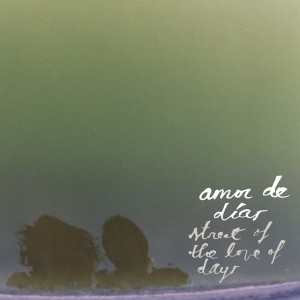Riffs, Rants & Rumors: Clientele Crooner Explores Amor de Dias
posted in: Features • Music News • Rock
 Ball games and Fourth of July picnics be damned” if you really want to feel outlandishly American, try talking to Clientele mastermind Alasdair MacLean and offering up your Yankee pronunciation of his longtime band’s moniker, only to find yourself feeling like Forrest Gump visiting the V&A Museum upon encountering his very English rendering of Clee-un-tel. It’s only fitting, though, since all the music MacLean has created up to now has been as undeniably English-sounding as John Houseman reading the complete works of Evelyn Waugh.
Ball games and Fourth of July picnics be damned” if you really want to feel outlandishly American, try talking to Clientele mastermind Alasdair MacLean and offering up your Yankee pronunciation of his longtime band’s moniker, only to find yourself feeling like Forrest Gump visiting the V&A Museum upon encountering his very English rendering of Clee-un-tel. It’s only fitting, though, since all the music MacLean has created up to now has been as undeniably English-sounding as John Houseman reading the complete works of Evelyn Waugh.
For the last thirteen years, The Clientele (however you choose to utter it) have crafted ethereal, hypnotic songs mixing the gentler end of British psychedelia”think Syd Barrett at his most unassuming”with wispy, Nick Drake-ish folk rock, for a haunting sound that’s been described as autumnal so often that singer/songwriter/guitarist MacLean finds the adjective’s ubiquity alarming. But now, with The Clientele on hold, MacLean has ventured into a more summery-sounding partnership with Pipas frontwoman Lupe Nunez-Fernandez as Amor de Dias, releasing the album Street of the Love of Days, out May 17 on Merge.
 One key to understanding MacLean’s leap from the sweater-weather sound of The Clientele to the warmer climes of Amor de Dias lies in examining an unexpected analogy: the works of Victorian-era British painter John Atkinson Grimshaw. They look like certain kinds of Clientele songs, explains MacLean. His pictures are incredibly atmospheric, kind of grim and quite ghostly. He’s very often used on the dust jackets of books in this country, so I loved his paintings for decades, but I only realized who he was about three years¦he’s actually just a working-class guy who decided to paint moonlight scenes. It’s very bleak and wintry, his art, and there’s definitely Clientele songs that could be an analog to that. Grimshaw’s pre-Raphaelite influences have a surprisingly strong connection to MacLean’s world. You can find something mysterious and odd and estranging in it. That’s definitely true of some of the pre-Raphaelite paintings. There’s one by Arthur Hughes called ‘The Death of Arthur’, which is King Arthur being laid to rest in these autumnal woods, and it absolutely echoes in every color the dull, suburban woods that I grew up around. In a way it’s quite magical, because it recontextualizes this Arthurian thing into these happy woods around the back of my house where I was growing up, in Hampshire¦about forty miles outside of London.
One key to understanding MacLean’s leap from the sweater-weather sound of The Clientele to the warmer climes of Amor de Dias lies in examining an unexpected analogy: the works of Victorian-era British painter John Atkinson Grimshaw. They look like certain kinds of Clientele songs, explains MacLean. His pictures are incredibly atmospheric, kind of grim and quite ghostly. He’s very often used on the dust jackets of books in this country, so I loved his paintings for decades, but I only realized who he was about three years¦he’s actually just a working-class guy who decided to paint moonlight scenes. It’s very bleak and wintry, his art, and there’s definitely Clientele songs that could be an analog to that. Grimshaw’s pre-Raphaelite influences have a surprisingly strong connection to MacLean’s world. You can find something mysterious and odd and estranging in it. That’s definitely true of some of the pre-Raphaelite paintings. There’s one by Arthur Hughes called ‘The Death of Arthur’, which is King Arthur being laid to rest in these autumnal woods, and it absolutely echoes in every color the dull, suburban woods that I grew up around. In a way it’s quite magical, because it recontextualizes this Arthurian thing into these happy woods around the back of my house where I was growing up, in Hampshire¦about forty miles outside of London.
At the suggestion that the Brazilian-influenced, sometimes bossa nova-tinged sounds of Amor de Dias represent a changing of the artistic seasons for MacLean, the songsmith muses, There’s more of a Latin thing to it, there’s more of a sunshine-pop feel to it, definitely. You’ve kind of floored me by saying that, because I hadn’t thought of it in that way. Now that I think of it, it is all quite summery, translucent music, isn’t it? So how much of this warming trend has to do with Nunez-Fernandez’s contributions? Probably all of it. Lupe definitely wrote a lot of the more cheerful and upbeat songs on this record and I wrote more of the spooky folk songs.
 The softer, dreamier end of the Brazilian Tropicalia explosion served as a key influence on Amor de Dias. I’m in love with the stuff Caetano Veloso did in the late ˜60s and early ˜70s, and Gal Costa as well¦we’re not doing crazy, Zappa-esque stuff like Os Mutantes, it’s more the ballads of Caetano Veloso, those were a huge influence on both of us when we made this record. In fact, MacLean’s love of Brazilian sounds goes back a ways. When the Clientele were just beginning, we all lived in an apartment together in a horrible bit of North London. We had a Spanish lodger¦he used to play a lot of the Vinicius Moraes stuff, and Edu Lobo, the classic bossa nova things, and everybody was kind of enchanted by that. You see it creeping into the Clientele, but one of the things about this record that’s very different from the Clientele is the rhythms. The Clientele are very much at heart a rock band. But the drummer we had for this record has a background in jazz¦we were able to have a little more rhythmic complexity.”
The softer, dreamier end of the Brazilian Tropicalia explosion served as a key influence on Amor de Dias. I’m in love with the stuff Caetano Veloso did in the late ˜60s and early ˜70s, and Gal Costa as well¦we’re not doing crazy, Zappa-esque stuff like Os Mutantes, it’s more the ballads of Caetano Veloso, those were a huge influence on both of us when we made this record. In fact, MacLean’s love of Brazilian sounds goes back a ways. When the Clientele were just beginning, we all lived in an apartment together in a horrible bit of North London. We had a Spanish lodger¦he used to play a lot of the Vinicius Moraes stuff, and Edu Lobo, the classic bossa nova things, and everybody was kind of enchanted by that. You see it creeping into the Clientele, but one of the things about this record that’s very different from the Clientele is the rhythms. The Clientele are very much at heart a rock band. But the drummer we had for this record has a background in jazz¦we were able to have a little more rhythmic complexity.”
So what does this new project mean for the longevity of MacLean’s other band? The Clientele are taking a rest because this is what I’m doing now, he says, But we haven’t split up. It was just time to take a break and let things rejuvenate. The Clientele had a lot of problems with money and with just being tired out by constant touring. And this project started as a way to bring back a kind of innocence and love of music that makes people form bands and write songs to begin with. The Clientele were really big fans of Pipas, Lupe’s band. We toured together a bit, and we just have been talking about how we should work together for ages and ages, and we finally had the chance to do it with this record.
Everyone from Damon and Naomi to Heather McIntosh of The Instruments became part of the album’s creative process, but in the end it’s all about the duo dynamic of MacLean and Lupe-Fernandez. It’s the first time I’ve ever collaborated, says MacLean, It’s humbling to collaborate and make music that’s better than when you’re on your own.
